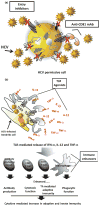HCV drug discovery aimed at viral eradication
- PMID: 20040045
- PMCID: PMC4064679
- DOI: 10.1111/j.1365-2893.2009.01246.x
HCV drug discovery aimed at viral eradication
Abstract
Hepatitis C virus (HCV) causes significant morbidity and mortality worldwide with nearly 3% of the world population infected by this virus. Fortunately, this virus does not establish latency, and hence it may be possible to eradicate it. HCV is strongly associated with liver cirrhosis and hepatocellular carcinoma and is currently treated with pegylated interferon-alpha (peg-IFN-alpha) and ribavirin. Unfortunately, these limited treatment options often produce significant side effects, and currently, complete eradication of virus with combined drug modalities has not yet been achieved for the majority of chronically HCV-infected individuals. Restricted treatment options, lack of a universal cure for HCV and the link between chronic infection, liver cirrhosis and hepatocellular carcinoma necessitate design of novel drugs and treatment options. Understanding the relationship between the immune response, viral clearance and inhibition of viral replication with pharmacology-based design can ultimately allow for complete eradication of HCV. This review focuses upon significant novel preclinical and clinical specifically targeted antiviral therapy (STAT-C) drugs under development, highlights their mechanism of action, and discusses their impact on systemic viral loads and permanent clearance of infection.
Figures


Similar articles
-
Novel therapeutic approaches for hepatitis C.Clin Pharmacol Ther. 2014 Jan;95(1):78-88. doi: 10.1038/clpt.2013.206. Epub 2013 Oct 14. Clin Pharmacol Ther. 2014. PMID: 24126682 Review.
-
Serine protease inhibitors as anti-hepatitis C virus agents.Expert Rev Anti Infect Ther. 2009 Jun;7(5):537-47. doi: 10.1586/eri.09.30. Expert Rev Anti Infect Ther. 2009. PMID: 19485794 Review.
-
Hepatitis C therapy: Looking toward interferon-sparing regimens.J Am Pharm Assoc (2003). 2015 Mar-Apr;55(2):e72-84; quiz e85-6. doi: 10.1331/JAPhA.2015.15508. J Am Pharm Assoc (2003). 2015. PMID: 25658389 Review.
-
Phase III results of Boceprevir in treatment naïve patients with chronic hepatitis C genotype 1.Liver Int. 2012 Feb;32 Suppl 1:27-31. doi: 10.1111/j.1478-3231.2011.02725.x. Liver Int. 2012. PMID: 22212568 Review.
-
Mechanisms of antiviral treatment efficacy and failure in chronic hepatitis C.Antiviral Res. 2003 Jun;59(1):1-11. doi: 10.1016/s0166-3542(03)00088-3. Antiviral Res. 2003. PMID: 12834855 Review.
Cited by
-
Synthesis and evaluation of novel potent HCV NS5A inhibitors.Bioorg Med Chem Lett. 2012 Jul 15;22(14):4864-8. doi: 10.1016/j.bmcl.2012.05.039. Epub 2012 May 24. Bioorg Med Chem Lett. 2012. PMID: 22704887 Free PMC article.
-
Cell-cell contact-mediated hepatitis C virus (HCV) transfer, productive infection, and replication and their requirement for HCV receptors.J Virol. 2013 Aug;87(15):8545-58. doi: 10.1128/JVI.01062-13. Epub 2013 May 29. J Virol. 2013. PMID: 23720720 Free PMC article.
-
Pharmacokinetics, safety, and tolerability of GS-9851, a nucleotide analog polymerase inhibitor for hepatitis C virus, following single ascending doses in healthy subjects.Antimicrob Agents Chemother. 2013 Mar;57(3):1201-8. doi: 10.1128/AAC.01262-12. Epub 2012 Dec 21. Antimicrob Agents Chemother. 2013. PMID: 23262999 Free PMC article. Clinical Trial.
-
Pharmacokinetics, pharmacodynamics, and tolerability of GS-9851, a nucleotide analog polymerase inhibitor, following multiple ascending doses in patients with chronic hepatitis C infection.Antimicrob Agents Chemother. 2013 Mar;57(3):1209-17. doi: 10.1128/AAC.01263-12. Epub 2012 Dec 21. Antimicrob Agents Chemother. 2013. PMID: 23263000 Free PMC article. Clinical Trial.
-
Rigid amphipathic fusion inhibitors, small molecule antiviral compounds against enveloped viruses.Proc Natl Acad Sci U S A. 2010 Oct 5;107(40):17339-44. doi: 10.1073/pnas.1010026107. Epub 2010 Sep 7. Proc Natl Acad Sci U S A. 2010. PMID: 20823220 Free PMC article.
References
-
- Heathcote J, Main J. Treatment of hepatitis C. J Viral Hepat. 2005;12(3):223–235. - PubMed
-
- Kim AI, Saab S. Treatment of hepatitis C. Am J Med. 2005;118(8):808–815. - PubMed
-
- Zaman A, Fennerty MB, Keeffe EB. Systematic review: peg-interferon vs. standard interferon in the treatment of chronic hepatitis C. Aliment Pharmacol Ther. 2003;18(7):661–670. - PubMed
-
- Schinazi RF, Sommadossi JP, Thomas H. Therapies for Viral Hepatitis. London: International Medical Press; 1998.
-
- Simmonds P, Holmes EC, Cha TA, et al. Classification of hepatitis C virus into six major genotypes and a series of subtypes by phylogenetic analysis of the NS-5 region. J Gen Virol. 1993;74(Pt 11):2391–2399. - PubMed
Publication types
MeSH terms
Substances
Grants and funding
LinkOut - more resources
Full Text Sources
Other Literature Sources

